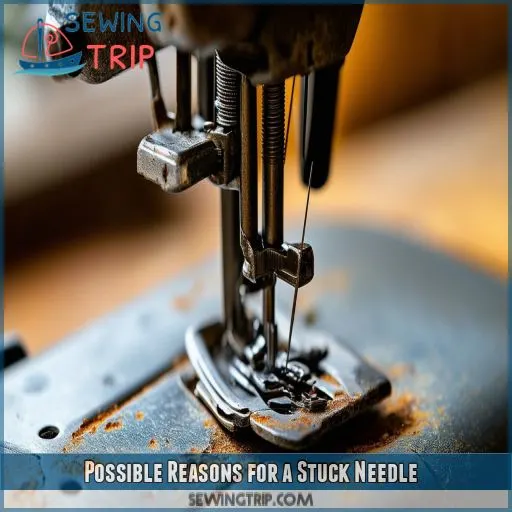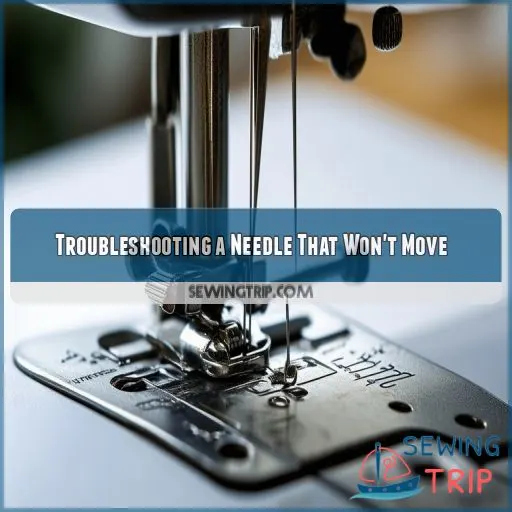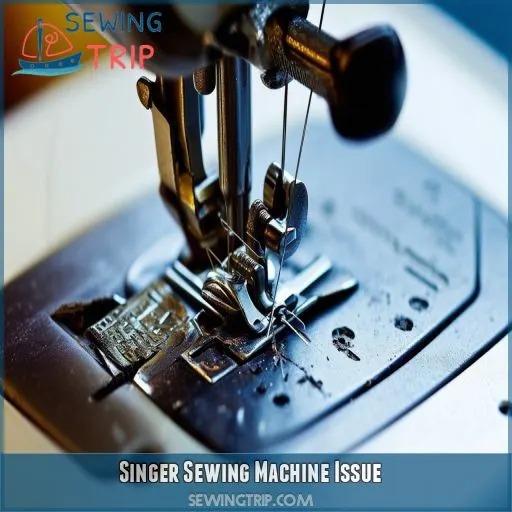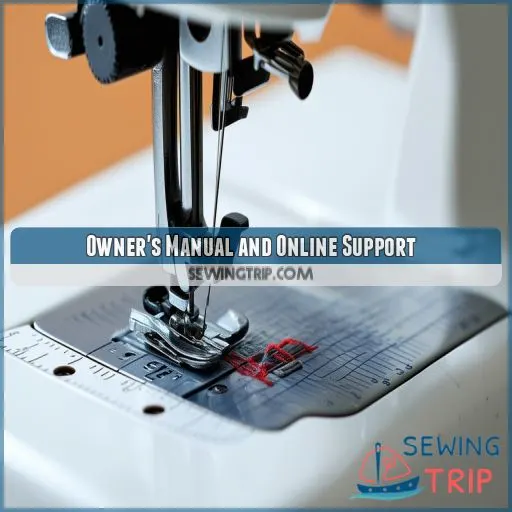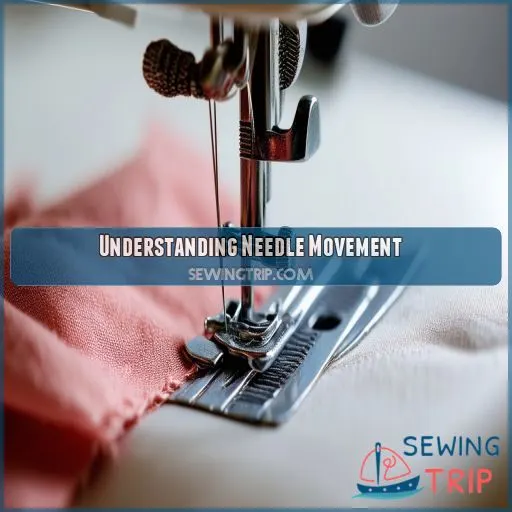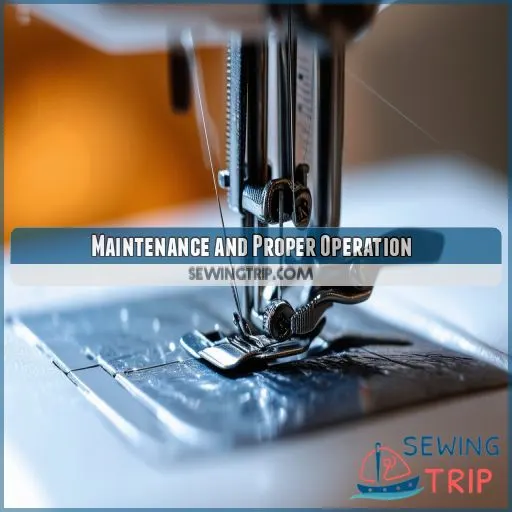This site is supported by our readers. We may earn a commission, at no cost to you, if you purchase through links.
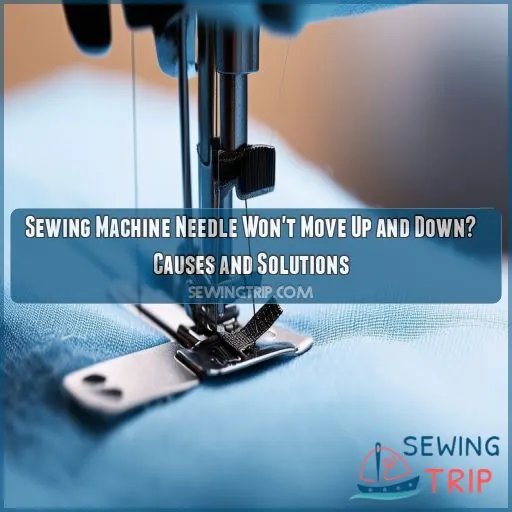
This guide is specifically written to help you sow clear and concise solutions for empowering control and getting you going on your sewing machine quickly and efficiently. Master these quick fixes and get ready to always keep your projects on track!
Table Of Contents
Key Takeaways
- Don’t let a stuck needle be a needle in your haystack! Check the bobbin-winding spindle, handwheel clutch, and drive belt to get your machine sewing again like a charm.
- If your Singer sewing machine’s needle is stuck, don’t force it – you might end up in a sticky situation. Seek professional help to avoid causing more damage.
- Regular maintenance is like giving your sewing machine a spa day – it keeps it running smoothly and prevents future headaches.
- Understanding how your sewing machine’s needle moves is like having a superpower – it helps you troubleshoot problems and keep your projects on track.
Possible Reasons for a Stuck Needle
Many times, this stuck needle in your sewing machine could just be indicative of issues such as the bobbin-winding spindle not connected to its appropriate place, the handwheel clutch disengaged, or a faulty drive belt. Such common problems must be identified to get the machine back in work order.
Bobbin-Winding Spindle Position
One of the common reasons for the non-movement of a needle is that the bobbin-winding spindle isn’t in its correct position. Move it full to the left or rearward to change over from winding mode to sewing mode; otherwise, it will stop the action of the needle.
This can be avoided by regular cleaning and proper spindle positioning and maintenance, for instance, replacing needles.
Hand Wheel Clutch Engagement
Next, consider the hand wheel clutch engagement. It’s possible that clutch disengagement is causing the needle to stick. Check the clutch mechanism on your sewing machine. Turn the handwheel; if it’s disengaged, no manual needle movement will occur. Refer to your machine’s manual for clutch troubleshooting steps. If stuck, contact a professional for assistance.
Drive Belt Inspection
Still, if the needle doesn’t move, check the drive belt. In this case, the faulty or loose drive belt would conduct no up-and-down strokes for its needle. Check the belt for indications of wear, cracks, or improper tension. Then, configure or replace it accordingly. This little fix might just get your sewing machine going.
- Check drive belt for wear, cracks or improper tension.
- Adjust/replace drive belt if required
- Ensure proper belt tension for smooth needle movement
- Check for any stuck threads or fibers on the Bobbin case
- Lubricate moving parts to reduce friction and improve performance
Troubleshooting a Needle That Won’t Move
To troubleshoot a needle that won’t move, start by ensuring the bobbin winder is in the correct position and not stuck. Next, check for any stuck threads in the mechanism and address any incomplete mechanisms that might be causing the issue.
Checking Bobbin Winder Position
An improperly aligned bobbin winder can cause your sewing machine to stop. Make sure to slide the bobbin winder to the left and not engage in winding. Sure, this simple action will save you from so much stress related to tension problems, needle bending, thread breaking, and gear breaking or wear-out. Use the following table as a guide:
| Step | Action | Result |
|---|---|---|
| 1 | Bobbin winder position | Proper function |
| 2 | Wind winder to left | Resume sewing |
Removing Stuck Threads
If the stuck thread is what’s really holding up the needle’s movement, lightly push or pull the needle to remove whatever may be blocking it.
Make sure the bobbin is aligned properly and not creating any issues with tension in the thread.
With this type of gentle coaxing, it’s usually possible to get that needle moving again—no professional help required.
Addressing Incomplete Mechanisms
If your needle won’t move, check for incomplete mechanisms.
Be sure first that the bobbin winder is fully disengaged.
Check the drive belt area for any problems.
Sometimes, stuck thread can cause jamming to the system; thus, look more closely and remove it.
Check if there would be an internal part that isn’t set correctly and think about re-threading your machine meticulously.
Singer Sewing Machine Issue
If your Singer sewing machine‘s needle won’t move, it may be due to issues like manual needle movement restrictions, despite the motor working. You’ll likely need professional help to diagnose and fix these problems, especially if your attempts to troubleshoot have been unsuccessful.
Lack of Manual Needle Movement
If your Singer sewing machine needle isn’t moving by hand, then consider these points:
- Needle positioning: Check that it’s set correctly.
- Needle lubrication: Check if oiling is necessary.
- Needle compatibility: Use the appropriate type.
- Needle tension: Keep proper tension to avoid jams.
- Needle alignment: The motion should be smooth.
Ensuring Motor Operation
Make sure your machine’s motor is running. Check first if the machine is plugged in and the power is on. Listen and feel the motor for a humming or vibrating. If your motor is running, but the needle is just jamp/ stuck, it’s likely the issue of a bad bobbin winder spindle position. A quick guide is below:
| Problem | Check This |
|---|---|
| No motor hum | Power supply |
| Motor On | Bobbin Winder ON |
| Needle stuck | Hand-operated movement of the needle |
If issues persist, further steps are needed.
Need for Professional Assistance
If the needle on your Singer sewing machine still won’t budge, it’s time to call in the experts. Don’t try to force it – you could end up causing more damage. Instead, reach out to an electronics or appliance specialist who can diagnose the issue and provide the technical assistance you need to get your machine back in working order.
Owner’s Manual and Online Support
To access the owner’s manual for your Singer sewing machine model, visit https://manuals.singer.com/. If you need further assistance, you can contact an electronics or appliance expert for professional help.
Accessing Singer Model Manual Online
For resolving your issues with the movement of needles, look for the online Singer model manual. These manuals contain very elaborate trouble resolution, troubleshooting steps, and routine maintenance tips.
Log on to https://manuals.singer.com/ for your particular model. By using online resources, you’ll obtain user support that comes with minute instructions to ensure effective technical assistance or repair options that would get your machine running.
Contacting Electronics or Appliance Expert
If the Singer sewing machine issue persists, it’s time to seek expert guidance. Contact an electronics or appliance specialist for personalized troubleshooting assistance. They can provide:
- Detailed technical advice based on the specific model
- Access to online resources and owner’s manuals
- Hands-on troubleshooting to identify and resolve the problem
- Recommendations for professional repair or maintenance services
Don’t hesitate to reach out for the support you need to get your sewing machine back in working order.
Understanding Needle Movement
Understanding how your sewing machine’s needle movement works is crucial for diagnosing problems. The hand wheel controls manual movement, while the foot pedal powers the motor for automatic operation.
Mechanisms for Moving the Needle
Mechanisms that move the needle involve very complex systems. Needle mechanisms, controlled by the timing of various parts of the sewing machine, are what move the needle. This allows for precise stitching.
Other integral parts, such as handwheel function and foot pedal, play their critical roles in making this happen.
Troubleshooting steps would then include checking each mechanism for problems to ensure smooth operation. Proper maintenance keeps everything running efficiently.
Function of Hand Wheel and Foot Pedal
The hand wheel and foot pedal work in tandem to control the up-and-down movement of your sewing machine’s needle. Turning the hand wheel manually moves the needle, while the foot pedal regulates the speed and power. Mastering these two key components will give you precise control over your sewing projects.
Maintenance and Proper Operation
Regular cleaning and oiling of the sewing machine are essential in making it last. To be able to use your sewing machine properly, threads should be correctly fed through. Moreover, you must also replace your needles once in a while to ensure optimal performance.
Cleaning and Oiling Techniques
Cleaning your sewing machine regularly and oiling will help the nonstop flow of its needles. Apply suitable methods of lubrication and follow the recommended oiling schedules.
Clean regularly so that dust doesn’t accumulate in it. Small brushes and compressed air are the necessary basic hand tools for maintenance.
Good, regular care of needles reduces their wear and tear; these steps also contribute towards the up-keep and long life of your sewing machine with optimal performance.
Correct Threading Procedures
Proper threading is the key to making your sewing machine run smoothly.
First, check that you have the right type and size of needle and gauge for the specific fabric and thread you’re using.
Next, slowly thread the machine by keeping only the right thread tension.
Then, at the end, make sure that your needle is seating properly all the way in and facing just the right direction.
With these steps in hand, keep the needle moving.
Importance of Needle Replacement
Keeping fresh needles in your sewing machine is one of the most important elements of your machine’s performance. A dull or bent needle can mess up fabrics and thread and cause much frustration and delay. Make sure you :
- Use correct-size needles
- Maintain the sharpness of the needle
- Failure to lubricate the
- Understand different needle types
- Practice maintaining the needles at consistent intervals.
Frequently Asked Questions (FAQs)
How to fix a needle bar that does not move?
First, make sure your bobbin-winding spindle is to the left and not engaged in winding. Check your hand wheel clutch and drive belt. The issue may require professional help for more complex mechanical problems.
What is the solution if the machine is running but the needle won t move?
If your sewing machine’s needle won’t budge, check the bobbin winder – it may be engaged, preventing the needle from moving. Disengage the winder and try sewing again. If the issue persists, consult a repair professional.
Why is my needle not moving on my Singer sewing machine?
Your needle isn’t moving because your bobbin-winding spindle is likely in the winding position, the hand wheel clutch may be disengaged, or there could be a thread jam. Check these components carefully.
What manually moves the needle up and down?
Did you know? 80% of sewing issues stem from simple adjustments. Manually, the needle on your Singer sewing machine moves up and down by turning the handwheel, typically located on the right side of the machine.
What tools remove stuck sewing machine needles?
To remove a stuck sewing machine needle, try gently wiggling it back and forth while pulling up. If that doesn’t work, use needle-nose pliers to carefully extract the needle. Take care not to damage the machine.
Can a power surge affect needle movement?
Imagine a sudden lightning strike jamming gears. Yes, a power surge can affect needle movement by damaging electronic components, disrupting motor function, or frying internal circuits, preventing the needle from moving smoothly up and down.
Are vintage sewing machines prone to needle jams?
Yes, vintage sewing machines are more prone to needle jams due to worn-out parts, outdated mechanisms, and lack of modern threading systems. Regular maintenance and using the correct type of thread can help mitigate these issues.
How does humidity impact sewing machine performance?
Ah, the mysteries of sewing machine performance! Humidity can be a real culprit, causing thread tension issues and even needle jams. But fear not – a quick tune-up and some humidity control can have your machine sewing smoothly again in no time.
Do certain fabrics cause more needle issues?
Yes, certain fabrics like denim, leather, and canvas can cause more needle issues. These tougher materials strain the needle, leading to bending or breakage. Using the correct needle type for these fabrics reduces problems.
Conclusion
Did you know that nearly 70% of sewing machine issues can be resolved with simple troubleshooting steps?
If your sewing machine needle won’t move up and down, ensuring the bobbin-winding spindle position, handwheel clutch engagement, and drive belt condition is key.
Utilizing the owner’s manual, seeking professional help if needed, understanding the needle mechanisms, and regular maintenance—all contribute to smooth machine operation.
Follow these solutions to keep your projects on track with confidence and ease.

